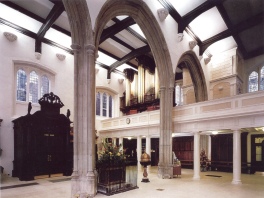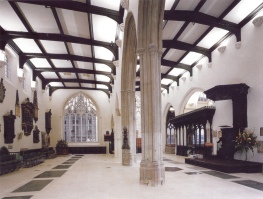

![]()

|

|


![]()

|

|
|
This project involved the complete restoration of the building following two IRA bombs in 1992 and 1993 in which the stained
glass windows and the stone east window were completely destroyed. The congregation had grown
considerably since the early 60s under the ministry of
Prebendary Dick Lucas and it had become increasingly difficult
for his preaching ministry to function efficiently in a
building that had been so radically altered in the 19th
century along Tractarian lines, with steps and screens and
spaces at different levels. It was therefore felt that this
would be the right moment to re-order the interior which was
long overdue. After carrying out some historical research it
became clear that the Victorian alterations had lowered the
floor from its mediaeval level by 3ft so that there were six
steps down into the building at the two West and South
entrances. There were also many drawings and engravings
showing the differences in levels and other details including
a small organ gallery at the west end.
As the current needs of the ministry fitted much better with the earlier Georgian layout of the building a design was prepared which reverted to the original Mediaeval plan and levels and restored a number of the original Georgian features. The Jacobean hexagonal pulpit remained in its central position on the south wall. The original Thomas Griffin (1742) organ which used to be in the west gallery (and had been moved to the South Transept during the 19th century) was restored and placed in a new gallery at the west end with additional space for seating. A new stone east window was erected at the end of the Nuns Quire and a new entrance with stone door surround was formed into the South Transept. The seating space was increased from a little over 500 to 1000 seats including new accommodation in the South Transept and gallery. The main Victorian screen designed by E L Pearson, which separated the clergy from the laiety, was moved 90 degrees and placed in the arch to the South Transept; thus all the original joinery features were kept but moved in position. Similarly the Georgian door cases were moved to accommodate their new positions and levels. The space between the Victorian level and the restored level was used for large ductwork which provides warm air through cast-iron grilles set in the new stone floor. |